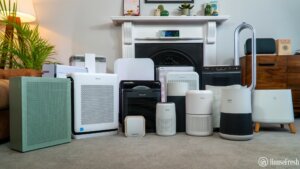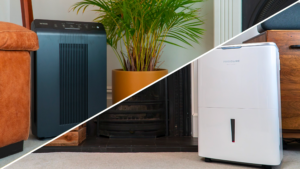All homes contain sources and appliances emitting carbon monoxide (CO); but the exposure level is generally safe. However, CO concentrations can sometimes rise, which may have serious health implications for you and your family.
Fortunately, we’re here to help you out. You’ll find important information below about the various sources of CO in the home, such as gas stoves and tobacco smoke. We’ll also look at practical ways to protect yourself from the dangers.
Carbon monoxide sources in the home
Carbon monoxide, or CO, is an odorless, colorless gas fuel combustion produces. CO is potentially toxic to humans and animals and there can be many sources in all homes, particularly those with fuel-burning appliances and attached garages.
Typically, concentrations of CO are lower in rural areas and higher in towns and cities. The level of CO indoors should be the same as outside the home. If you find that concentrations are higher indoors, this suggests that a potent source of CO is either inside or very close to your home.
The various sources of CO in our homes include:
🍳 Gas stoves and kitchen ranges — CO can be produced without proper ventilation, such as a range hood.
🔥 Fireplaces, including those that are gas and wood burning — some people may use fireplaces more frequently in winter, but this can increase CO levels, especially if the flue isn’t opened.
🛠️ Grills, power tools and lawn equipment — grills can be particularly dangerous if used in an enclosed space like a garage as the burning fuel may lead to toxic concentrations of CO.
🚬 Tobacco smoke — this can be a prime source of CO both for people who smoke and those they come into contact with. Smoking in an enclosed room increases the risk of CO exposure.
👕 Clothes dryers, water heaters and furnaces or boilers — without sufficient ventilation, these appliances can cause CO exposure in your home.
🔌 Gas-powered portable generators — as these can produce high levels of CO, it’s always recommended to use them outside.
🚗 Motor vehicles, such as cars and RVs — on icy mornings, many people run their vehicles for a few minutes inside their garage. Yet this can lead to the accumulation of CO, and it may even spread to your home.
Here are some red flags to keep an eye out for:
🚩 Excess moisture and condensation on windows, walls and cold surfaces.
🚩 Traces of soot around fuel-burning appliances, or you might see fallen soot in a fireplace.
🚩 Flue pipes or appliance jacks have noticeable rust.
🚩 The top of the chimney has damaged or discolored bricks, and/or an upward draft is absent.
🚩 Combustion appliances have an orange or yellow flame rather than the normal blue.
Protecting your family from CO poisoning
Here are some fundamental things you can do today to protect yourself and your family from CO poisoning
Tip 1: Maintain all fuel-burning appliances
All fuel-burning appliances, such as oil and gas furnaces, gas water heaters, fireplaces and wood stoves, should be inspected by a trained professional every year. The start of every heating season is a good idea.
Also, ensure the flues and chimneys are connected, not blocked and in decent condition.
Tip 2: Vent all fuel-burning appliances to the outside
Whenever possible, choose appliances that vent their fumes to the outside. Be aware that horizontal vent pipes for devices, such as a water heaters, should go up slightly as they go toward the outdoors.
This helps to prevent CO from leaking if the joints or pipes aren’t fitted tightly.
Tip 3: Read carefully and follow all instructions for any fuel-burning device
Following any device’s cautions is crucial, especially if you cannot avoid using appliances such as an unvented gas or kerosene space heater.
Tip 4: Install and maintain CO detectors in your home
While prevention is better than cure, installing a battery-operated CO alarm in your home is essential.
✅ Place the alarm outside your bedroom, as this will wake you up if it sounds.
✅ A good time to check or replace the battery is when you change the time on your clocks every spring and fall.
✅ Think about getting an alarm with a digital readout, as this will sound the alarm and tell you CO concentrations in your home. We love this one and have seen it in action.
5 bonus CO-busting tips
1. Don’t ever be tempted to use appliances intended for outdoor use inside the home. These include camp stoves, barbecue grills and portable generators.
2. Do not use a gas oven to heat your home. This is both a CO hazard AND a fire risk.
3. Never allow anyone to sleep in a room that has an unvented gas or kerosene space heater.
4. Do not idle or run your car or vehicle in an attached garage, as fumes can build up quickly.
5. Consider using a high-quality air purifier with True HEPA and activated carbon filters.
Conclusion
Even low levels of CO exposure can affect your health, so it’s vital to maintain and use all fuel-burning equipment safely. Installing and checking CO alarms regularly will also help to safeguard your health.
Equally, being able to tell the difference between CO poisoning and the flu means that you can take action as soon as you recognize the symptoms.
Remember that one fundamental way to tell if you have CO poisoning is that you’ll probably feel much better outside your home or the affected room.
SOURCES
- Ashton, D. (2022). HouseFresh. Do Air Purifiers Remove Carbon Monoxide? housefresh.com
- Centers for Disease Control and Prevention. (2023). What is Carbon Monoxide? cdc.gov
- Centers for Disease Control and Prevention. (2023). Carbon Monoxide (CO) Poisoning Prevention. cdc.gov
- Cleveland Clinic. (2020). Carbon Monoxide Poisoning. my.clevelandclinic.org
- Environmental Protection Agency. (2022). Protect Your Family and Yourself from Carbon Monoxide Poisoning. epa.gov
- Felson, S. (2021). Carbon Monoxide Poisoning Treatment. webmd.com
- Kidde. (2022). Carbon Monoxide Laws. kidde.com
- Minnesota Department of Health. (2022). Carbon Monoxide (CO) Poisoning in Your Home. health.state.mn.us
- NHS. (2022). Carbon monoxide poisoning. nhs.uk
- Poslusny, C. (2018). Molekule. Where Does Carbon Monoxide Come From in a Home? molekule.com






